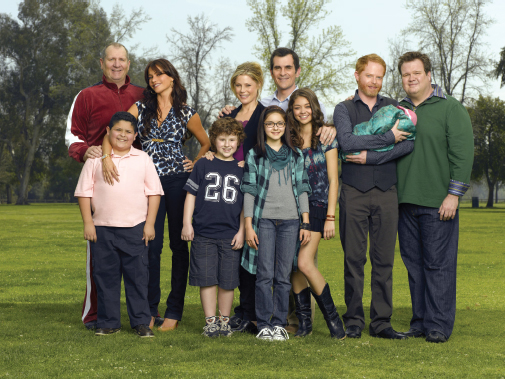TV Entertainment: Our Comic Culture
The networks began to move their entertainment divisions to Los Angeles partly because of the success of the pioneering comedy series I Love Lucy (1951-57). Lucy’s owners and costars, Lucille Ball and Desi Arnaz, began filming the top-rated sitcom in California near their home. In 1951, Lucy became the first TV program to be filmed before a live Hollywood audience. Prior to the days of videotape (invented in 1956), the only way to preserve a live broadcast, other than filming it like a movie, was through a technique called kinescope. In this process, a film camera recorded a live TV show off a studio monitor. The quality of the kinescope was poor, and most series that were saved in this way have not survived. I Love Lucy, Alfred Hitchcock Presents, and Dragnet are among a handful of series from the 1950s that have endured because they were originally shot and preserved on film, like movies. In capturing I Love Lucy on film for future generations, the program’s producers understood the enduring appeal of comedy, which is a central programming strategy both for broadcast networks and cable. TV comedy is usually delivered in three formats: sketch comedy, situation comedy (sitcom), and domestic comedy.

Source: TV Guide, “America’s Most Watched: The Top 25 Shows of the 2012–2013 TV Season,” June 10, 2013, http://www.tvguide.com/news/most-watched-tvshows-top-25-2012-2013-1066503.aspx.
Sketch comedy, or short comedy skits, was a key element in early TV variety shows, which also included singers, dancers, acrobats, animal acts, stand-up comics, and ventriloquists. The shows “resurrected the essentials of stage variety entertainment” and played to noisy studio audiences.9 Vaudeville and stage performers were TV’s first stars of sketch comedy. They included Milton Berle, TV’s first major celebrity, in Texaco Star Theater (1948-1967); and Sid Caesar, Imogene Coca, and Carl Reiner in Your Show of Shows (1950-54), for which playwright Neil Simon, filmmakers Mel Brooks and Woody Allen, and writer Larry Gelbart (M*A*S*H) all served for a time as writers. Today, NBC’s Saturday Night Live (1975— ) carries on the sketch comedy tradition.

However, the hourlong variety series in which these skits appeared were more expensive to produce than half-hour sitcoms. Also, these skits on the weekly variety shows used up new routines very quickly. The ventriloquist Edgar Bergen (father of actress Candice Bergen) once commented that “no comedian should be on TV once a week; he shouldn’t be on more than once a month.”10 With original skits and new sets being required each week, production costs mounted and the vaudeville-influenced variety series faded. Since the early 1980s, network variety shows have appeared only as yearly specials.
The situation comedy, or sitcom, features a recurring cast; each episode establishes a narrative situation, complicates it, develops increasing confusion among its characters, and then usually resolves the complications.11 I Love Lucy, The Beverly Hillbillies, Seinfeld, 30 Rock, The New Girl, and FX’s It’s Always Sunny in Philadelphia are all examples of this genre.
In most sitcoms, character development is downplayed in favor of zany plots. Characters are usually static and predictable, and they generally do not develop much during the course of a series. Such characters “are never troubled in profound ways.” Stress, more often the result of external confusion rather than emotional anxiety, “is always funny.”12 Much like viewers of soap operas, sitcom fans feel just a little bit smarter than the characters, whose lives seem wacky and out of control.

In a domestic comedy, characters and settings are usually more important than complicated predicaments. Although an episode might offer a goofy situation as a subplot, more typically the main narrative features a personal problem or family crisis that characters have to resolve. Greater emphasis is placed on character development than on reestablishing the order that has been disrupted by confusion. For example, an episode from domestic comedy All in the Family (1971–1983) shows archconservative Archie and his ultraliberal son-in-law, Mike, accidentally locked in the basement. The physical predicament becomes a subplot as the main “action” shifts to the characters themselves, who reflect on their generational and political differences. Contrast this with an episode of the sitcom Happy Days (1974–1984), where the plot focuses on how the characters are going to free themselves after they are accidentally locked in a vault over the weekend. Domestic comedies take place primarily at home (Modern Family ), at the workplace (Parks and Recreation), or at both (HBO’s Curb Your Enthusiasm).
Today, domestic comedies may also mix dramatic and comedic elements. This blurring of serious and comic themes marks a contemporary hybrid, sometimes labeled dramedy, which includes such series as The Wonder Years (1988–1993), Ally McBeal (1997–2002), HBO’s Sex and the City (1999–2004), Showtime’s The Big C (2010–13), and Fox’s popular musical-dramedy Glee (2009– ).